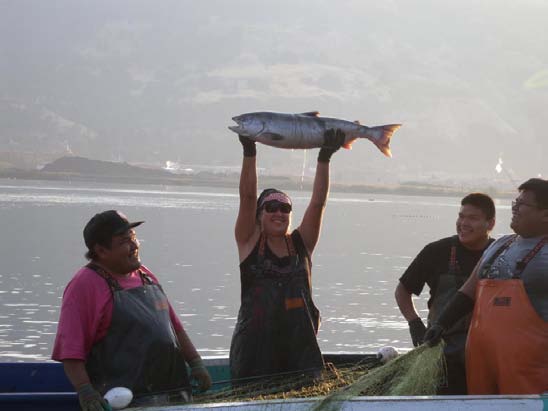forum
library
tutorial
contact

EIS Process Started for U.S. v. Oregon
Post-2017 Harvest Actions
by Laura Berg
NW Fishletter, August 1, 2016
|
the film forum library tutorial contact |

|
EIS Process Started for U.S. v. Oregon
by Laura Berg
|
 NOAA Fisheries and the U.S. Fish and Wildlife Service on July 1 announced their intent to prepare an environmental impact statement to review harvest actions related to a post-2017 U.S. v. Oregon Management Plan.
NOAA Fisheries and the U.S. Fish and Wildlife Service on July 1 announced their intent to prepare an environmental impact statement to review harvest actions related to a post-2017 U.S. v. Oregon Management Plan.
Entered as a court order in 2008, the U.S. v. Oregon Management Plan expires Dec. 31, 2017.
The management agreement details harvest and hatchery measures in the Columbia River Basin to comply with treaty fishing rights decisions in U.S. v. Oregon, a case dating back to 1968.
The tribal, state and federal parties are currently negotiating a new agreement that would take effect when the existing agreement ends.
The two federal agencies will prepare the EIS, for a "Programmatic Review of Harvest Actions for Salmon and Steelhead in the Columbia River Basin Related to U.S. v. Oregon," in consultation with the treaty tribes, to inform the two agencies' signing of the new management plan.
While the EIS is conducted under the National Environmental Policy Act, it will also be used in the subsequent Endangered Species Act Section 7 consultation on the new agreement.
The federal agencies have identified six management options that might be used: the current harvest arrangement, an abundance-based management framework, a fixed exploitation rate framework, an escapement-based framework and a no-fisheries alternative.
Although the latter option "does not meet the purpose and need for the proposed action, it is included to provide a full range of alternatives for analysis," the Federal Register notice says.
The purpose of the new agreement is to "ensure fair sharing of harvestable fish between tribal and non-tribal fisheries in accordance with treaty fishing rights standards and U.S. v. Oregon, and to be responsive to the needs of ESA-listed species," according to the notice.
The current U.S. v. Oregon Management Plan uses an abundance-based approach to regulate harvests.
While the new management plan will stipulate levels of hatchery production, the EIS produced by NOAA and USFWS will focus on harvest.
The EIS will incorporate the {http://www.westcoast.fisheries.noaa.gov/hatcheries/mitchell_act/ma_feis.html 2014 EIS on Columbia basin hatchery production}--or possibly a supplement to it--by reference in the new, harvest-related impact statement.
The Federal Register notice said that the construction of new hatchery facilities to mitigate fish impacts from The Dalles and John Day dam hydropower operations is being analyzed by the U.S. Army Corps of Engineers in a separate analysis, which will also be incorporated by reference in the EIS.
The impact statement will evaluate the effects the various alternatives would have on Columbia basin fish species and on other aspects of the human and natural environment, the notice said.
NOAA Fisheries and the USFWS are asking for comments, information and suggestions from the public and are particularly interested in input on:
Comments on the notice of intent will be accepted through Aug. 1, 2016, by email or mail addresses listed in the Federal Register notice.
learn more on topics covered in the film
see the video
read the script
learn the songs
discussion forum
